ImPulsTanz Or When All Of Vienna Is Dancing
One of the largest and oldest dance festivals in Europe takes place every July in Vienna. Dozens of different dance workshops, up to eight full-length performances and other accompanying programmes, including films or open-air classes, are offered every day in several cultural institutions and outdoor spaces. I had the opportunity to spend six days at the festival during the third week of the festival and see and experience relatively a lot at a time when ImPulsTanz - Vienna International Dance Festival was taking over Vienna with queer themes, physicality and LGBT+ issues were being explored especially by younger choreographers.
Dance inspired by the present and history
For several years now, the 8:tention production company, which focuses on young choreographic talents, has been involved in the festival programme. During the third week of the festival, it offered three choreographies, which I would call the most interesting of the 3rd week of the festival, together with the performance FUCK ME by choreographer Marina Otero. The first of these took place in the alternative space of the Burgtheater, the lavish halls of the former casino on Swanzemberzplatz. Anna Biscók, a Hungarian living and working in Austria, performed her choreography DELICATE here.
It was a fascinating spectacle of a trio of young ladies, mature dancers, who bravely treated the theme of otherness and similarity. Each of them comes from a different country (Hungary, Ukraine, Austria), each speaks a different language, has different experiences and backgrounds, yet they understand each other on many topics and can laugh at similar memories. At first, in idle sittings, they informally verbalize what touches them, each in their own way and in their own language, yet very similarly. Then the same thing begins to happen in motion. The individuality of each of them is apparent at first sight. Although the choreographer has based the work on more or less one quality of movement, this has been worked out from the perspectives of three personalities, three physical experiences. Some were intertwined, others the opposite, which could be seen in the work with space. I could feel a tremendous energy from the three young women, attuned to themselves and to the audience. Dance was presented as a universal means of communication - each of the dancers express themselves differently in movement, yet they understand each other.
Another performance produced by 8:tention was the work of James Batchelor, who is known to Czech audiences from the KoresponDance festival, where he has performed in several editions. Although he comes from Australia, his connection to Europe is quite strong through dance. His dance teacher, Ruth Osborne, practiced the Viennese style of modern dance in Australia, which was brought to the antipodeans by Austrian Gertrud Bodenwieser, who was fleeing the Nazis. The dance performance is interspersed with archival videos of both Batchelor's teacher Ruth Osborne and Gertrud Bodenweiser herself, in which both present a journey of expressive modern dance (Ausdruckstanz).
Both ladies present a method, even in terms of age, based on arm and upper body movement. James Batchelor then, as if through a photocopy, reconstructs the movement of the arms, develops it more in space, uses repetition of the original movement and minimal transformations to lead it to completely different variations. In this performance, Batchelor embarks on a historical probe, exploring the functionality of expressive dance in the present day, and the result is a brilliantly executed homage not only to the two ladies, but to the process and changing forms of dance.
Through the reconstruction of movements and vivid narrative, it preserves the legacy of Viennese dance modernism and spreads it further. With its theme, this performance has definitely found its place in the programme of Austria's largest dance festival. Perhaps because the main role is played by two ladies, Batchelor has invited a colleague on stage who, like him, reconstructs the movements of the aforementioned dancers. It may seem that it is “just” a doubling, but it is a well thought out and interesting concept for the audience.
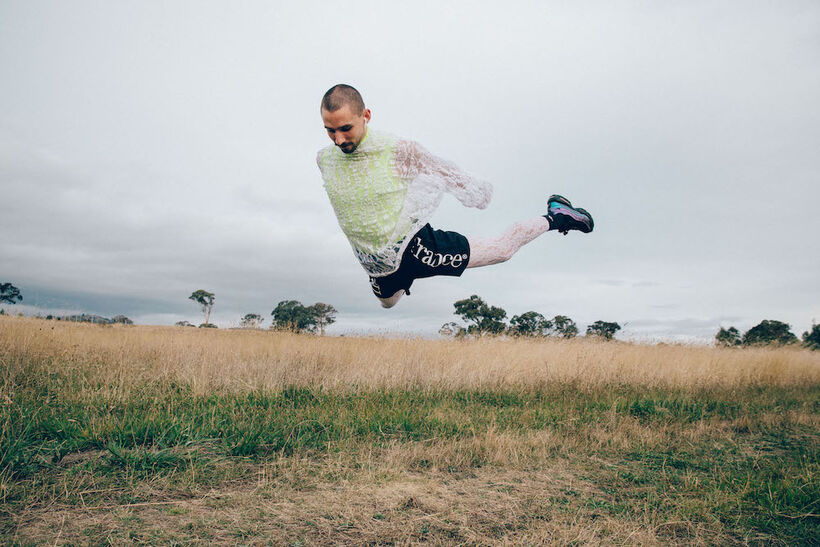
Although they both do virtually the same thing on stage, they have a clearly timed delay of one or the other, creating a kind of canon, sometimes involving changes of direction in turns and jumps. They both float gracefully through space, their arms, especially Batchelor's, seeming to paint aerial pictures. To complete the overall sensation, there is a guitarist on stage who has created a bespoke electronic score that at times transcends into the bodies of the actors as well as the audience. The music is in complete harmony with the movement, but seems to be constantly faster than the movements themselves. The choreography was full of tension, a strong message and an absolutely vivid history.
Batchelor is not the only one who has attempted to reconstruct dance history through documenting the movements and narratives of old ladies. Boglarka Börcsök brought a similar theme here in Vienna last year in her production FIGURING AGE. This year it was possible to see this work at the Divadelní Flora Olomouc festival.
From undisguised animality to the destruction of ageing
The third production Batty Bwoy was an intimate confession by Harald Beharie, a Jamaican native living in Norway. It dealt with black queer people and their bodies immersed in destructive fantasies. Harald's energy is incredible, his total immersion in the role is also admirable. He is helped to keep the pace set by the equally energetic music, which has moved many a viewer.
Beharie provokes - he is enclosed together with the audience in the small space of the exhibition hall of the MUMOK Museum of Modern Art with one red table. He moves millimetres close to all the newcomers, he waits for their gaze, he conditions their proximity. His performance is at times eerie, at others playful. He moves completely invisible muscles on his naked body, licks his sweat, smears saliva on his hair and penis. Animalism stands above all. His imagination goes far. In his performance, both nudity and copulation movements are completely natural, free of shame and all taboos, and it doesn't matter what kind of body it is. Beharie delivers a mesmerizing performance that will resonate in the bodies and memories of the audience for a long time.
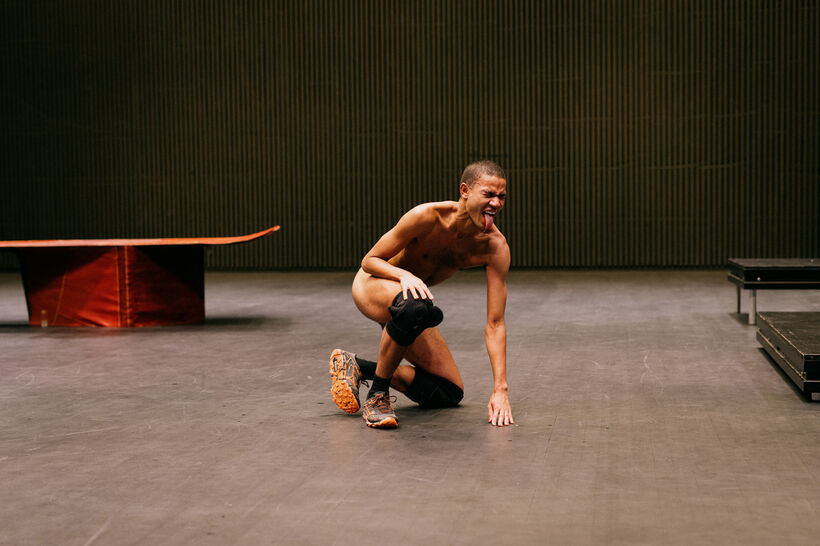
Other projects were taking place in the gallery space. In MUMOK, it was possible to experience Akemi Takeya's Dadaist sketch entitled The Act of LemoDada. She is an artist with Japanese roots who has been working in Austria for a long time. Her work is associated with Dadaism. However, this work was merely a showcase of ego and randomly chosen themes without any deeper concept.
In the Leopold Museum, on the other hand, there was a very unconventional and slightly provocative duration performance by the Austrian duo Toxic dreams called The Two Pop(e)s. Two elderly gentlemen, Yosi Wanunu and Roland Rauschmeier, in the roles of two popes, dramatized themes such as aging, time and dying, art history, and communication between the works. The whole concept was inspired by two paintings, masterpieces: a portrait of Pope Inocent X by Diego Velázquez from 1650 and a painting of the same pope by Francis Bacon entitled Study after Velázquez's Portrait of Inocent X (1953). The Pope himself posed for Velázquez and upon its completion declared, "It is too true!" Francis Bacon, on the other hand, had never seen Velázquez's painting; he worked from a photograph and other found materials. This movement art interpretation includes fictional conversations between Velázquez and Bacon not only about the paintings themselves, but also about other existential themes.
Both Pope/performers Yosi Wanunu and Roland Rauschmeier thus represent weariness, despondency, unhappiness, joyless states and despair. The performance was conceived as an open form and could be attended at any time within the time frame indicated. The audience often became part of a prepared but rather improvised concept. Due to the focus of the museum, the creative duo also worked with the visual component and had a very expressive, even terrifying make-up. They moved around a rainbow carousel created on the ground made up of coloured ribbons. What was really impressive was the view from above, which the museum allowed from several points.
Big names and big expectations
Meg Stuart's production of BLESSED brought a much-needed theme of the transience of wealth, the annotation promising a deep reflection on what happens when one suddenly loses everything one has built, everything one has owned. The entire work is based on the story of one man whose house, palm tree and swan are taken away by a long and incessant rain. At first, he tries to salvage some kind of roof over his head from the remains of his possessions, but the rain gradually washes away all his efforts and takes away everything that gave him confidence and self-esteem. His confident, almost boastful, way of walking turns into moving on all fours, moving on the ground. There's grace and pride there. All that's left is his underwear and cape.
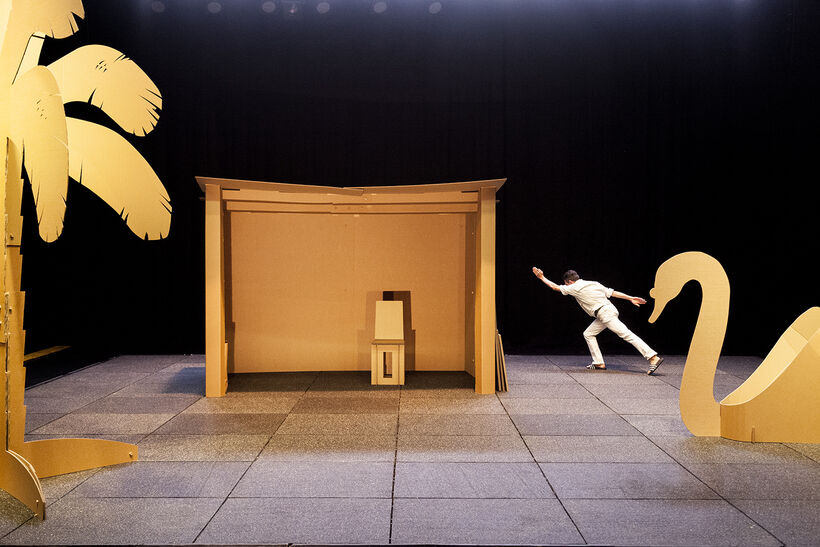
Stuart's confession is also interwoven with dreams and memories of a past life of wealth and luxury, symbolised, for example, by the shantan dancer or his extravagant disguises. Overall, I couldn't help feeling that the depth of this story is lacking, the individual passages are excessively long, giving the impression that nothing substantial (with a few exceptions) happens in them, probably meant to symbolize those long and tedious hours of transposition into another life.
However, I was very annoyed that in a production attempting to communicate and convey a vision of detachment from material things, which I see as an attempt to live a more ecological and sustainable way of life, several hectolitres of water are then wasted in one performance. It rained for almost the entire 90-minute production. So a strange take on the theme of wealth, waste and luxury...
Another strange message was delivered in Madrigals by composer Benjamin Abel Meirhaeghe and Muziektheater Transparant from Belgium. Without much warning, the viewer finds themselves in a utopian world where men and women are equal, standing before each other completely naked and forming a community sharing rituals, habits and needs. Their existence is set musically in the late Renaissance and early Baroque periods. This young composer has reworked Claudio Monteverdi's Madrigali guerrieri ed amorosi for four musicians who perform the pieces directly on stage. The singing is shared by the musical actors themselves.
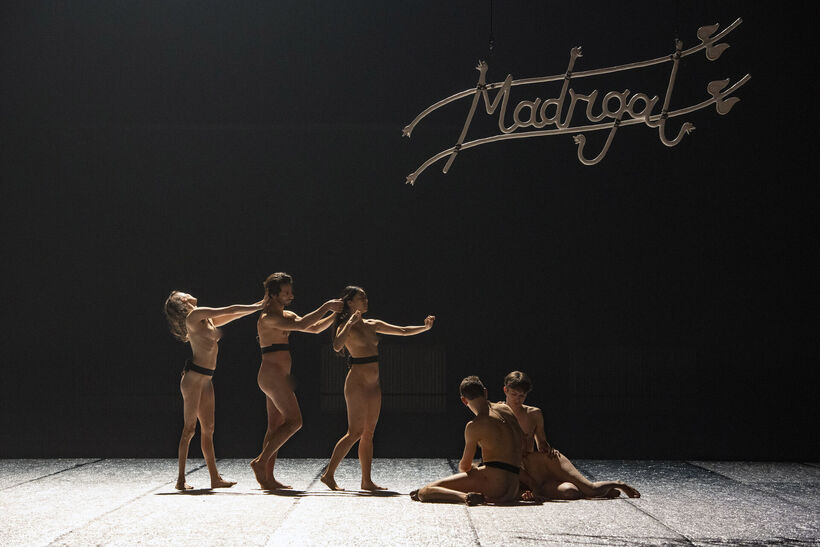
The performance plays with different visual effects, lights, even as part of a community ritual the actors make fire on stage, projections and modern tapestries symbolize the cave in which the community is located. But really, it was a strange fusion of the old and the modern, and a vain attempt to prove that even these seemingly incompatible things can be merged.
Dance in film
Somewhat ancillary, but not unimportant, component of the programme were some dance films that ImPulsTanz presented together with the National Austrian Film Archive. One of them was a film by the dance group Alain Platel, following or based on their successful dance performance Nicht Schlafen, which opens up and treats the theme of violence. The film depicts excerpts from the performance interspersed with interviews with dancers of different nationalities and cultures who talk about how they feel destined to hurt. How they were raised in a context of male-female dominance and attitudes towards violence. It is a riveting and open testimony, an acknowledgement and reflection on changing learned and acquired patterns of behaviour.
The next film offered for viewing was Monochrome, a short 15-minute film by Anton Ovchinnikov who, after a long isolation during the covid pandemic, felt the need to process the theme of pure nature, stopping, focusing, and solitude. It was the first step after stepping out of the stupor.
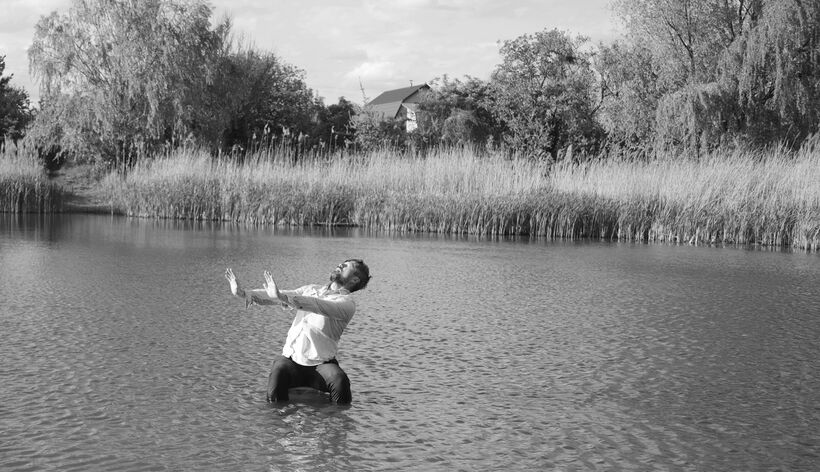
Discovery at the end
The last production I saw before I left, and mentioned in the introduction, was the provocative FUCK ME by Marina Otero, an Argentinian playwright with a powerful life story. As a dancer and choreographer she was provocative, successful and talented until she was injured and spent a year in hospital. During that time, several themes bubbled up inside her: Would she still be in demand? Would her body and moves be as sexy as ever? At the same time, she was wrestling with memories of her grandfather, an intelligence officer in Argentina's military dictatorship. All of this is written into her funny and cynical production FUCK ME, which is actually a kind of collage of film snippets of her dancing life before her surgery, when she felt sexy and lived a very unrestrained life, and her life now.
She works with the concept of retelling her past with annotated entries that she directs herself. In real time, she sits rigid on the edge of the stage, conducting five naked dancers with military caps on their heads. After some time, she rises to her feet and crosses the stage in a slow motion, slightly bowing, to lightly join in the action. She has a very close relationship with each of the dancers, adoring each in a different area, one is strong, one small and agile - the one originally dancing her passages, the other a good partner support. They are all great, have well-developed bodies and are naked or half-naked on stage most of the time. They play her funny game with Marina, but there is very little rivalry between them.
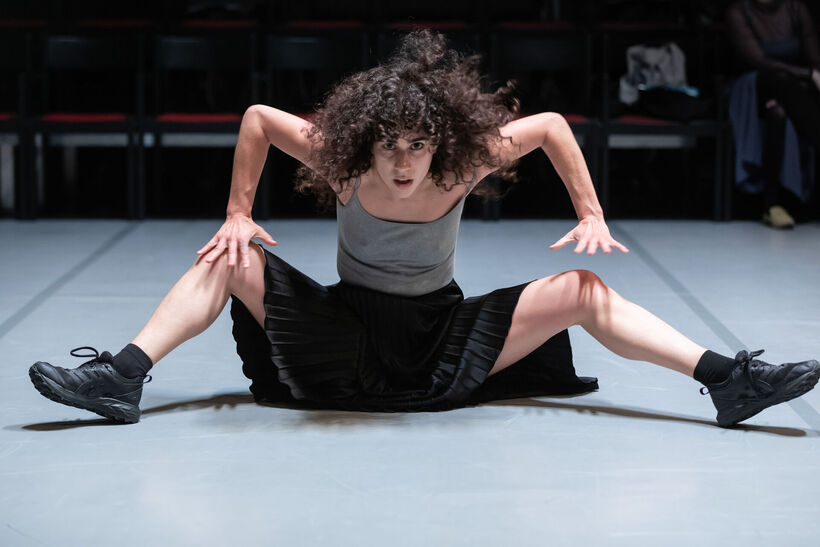
The production offers a fresh and relaxed experience, and although there is a great deal of pain, the story is presented in such a cheerful and charming way that it does not evoke any feeling of regret. At the end, however, there is an absolutely thunderous euphoria. Marina Otero appears naked on stage, running around and shouting into the microphone, “This is my gift to you, enjoy it, but remember that I will be running around until the last of you leave this hall.” And so, fascinated, I left the hall full of hope and satisfaction. It's just a shame I hadn't caught Otero's follow-up production, LOVE ME. So maybe next time.
Written from 21 - 27 August 2023, ImPulsTanz - Vienna International Dance Festival.
The LemoDada Act
Akemi Takeya (AT/JP)
Concept, staging, text, choreography and performance by Akemi Takeya
Produced by Akamiya Takei, directed by A: IMEKA 2023
In cooperation with ImPulsTanz - Vienna International Dance Festival and MUMOK - Museum Moderner Kunst Stiftung Ludwig Wien
Why We Fight?
Alain Platel & Mirjam Devriendt / Cassette for timescapes (BE)
Writers and directors: Alain Platel and Mirjam Devriendt
Inspired by: the dance performance Nicht Schlafen by Alain Platel
Edited by Dieter Diependaele
Director of photography: M: Mirjam Devriendt
Sound: M: Jean-François Levillain
Composer: Mgr: Steven Prengels
Producers: Mgr: Emmy Oost, Magalie Dierick
Co-producers: M: Christian Beetz, Tuan Lam
DELICATE
Anna Biczók (AT/HU)
Artistic direction, choreography: Anna Biczók
Performance, choreography: Mgr: Adél Juhász, Karin Pauer, Sasha Portyannikova
Music accompaniment: Mgr. Rozi Mákó
Light Design: Kata Dézsi
Costumes: M: Csenge Vass
Graphics: M: Bori Mákó
Assistant Choreographer: M: Virág Arany
Partner: Mgr: Partner: Workshop Foundation
Monochrome
Anton Ovchinnikov / Black O!Range productions (LT/UA)
Choreographer, performer, composer: Anton Ovhinnikov
Anton Ovhinnikov
Anton Ovhinchev Anton O!Range Productions
Madrigals
Benjamin Abel Meirhaeghe / Muziektheater Transparant (BE)
Benjamin Abel Meirhaeghe
Hanako Hayakawa, Alice Giuliani, Els Mondelaers, Lucie Plasschaert, Khaled Barghouthi, Clément Corrillon, Victor Dumont, Antonio Fajardo
Choreography by Sophia Rodriguez in collaboration with the performers
Madoka Nakamaru, Wouter Deltour, Pieter Theuns, Rebecca Huber from David Wish
Music by Doon Kanda (aka Jesse Kanda), Claudio Monteverdi
Musical direction, co-written by Wouter Deltour
Dramaturgy, research: Louise van den Eede
Set design, lighting design: Zaza Dupont, Bart van Merode
Visual artists: Sanam Khatibi, Justin Fitzpatrick, Thomas Renwart, Anthony Ngoya, Gilles Dusong, Christiane Blattmann, Daan Couzijn, Che Go Eun, Tom Hallet, Nokukhanya Langa, Tristan Bründler
Video by Filip Anthonissen
Costumes: Kasia Mielczarek
Batty Bwoy
Harald Beharie
Choreography and performers: Harald Beharie
Artistic Collaborators: Karoline Bakken Lund and Veronica Bruce
Sculpture by Karoline Bakken Lund and Veronica Bruce
Composer: Ring van Möbius
Sound engineer: Jassem Hindi
External Eye: Hooman Sharifi, Inés Belli
Shortcuts to Familiar Places
James Batchelor & Collaborators (AU)
Choreography, performance by James Batchelor
Dramaturgy, production by Bek Berger
Composition by Morgan Hickinbotham
Performance by Chloe Chignell
Lighting design by Vinny Jones
Costume design: Juliane König
Video editing: Margie Medlin
Videography by James Batchelor
Choreographic advice: Ruth Osborne, Eileen Kramer, Carol Brown
Research Advice: Michelle Potter
FUCK ME
Marina Otero (AR)
Dramaturgy and direction by Marina Otero
Cast: Augusto Chiappe, Juanfra López Bubica, Fred Raposo, Matías Rebossio,
Miguel Valdivieso, Cristian Vega, Marina Otero
Assistant Director: Lucrecia Pierpaoli
Production: Mariano de Mendonça
Space, lighting/technical direction: David Seldes, Facundo David
Space and lighting design: Adrián Grimozzi
Costumes: Uriel Cistaro
Sound design and original music by Julián Rodriguez Rona
Dramatic Council: Martín Flores Cárdenas
Choreographic assistance: Lucía Giannoni
Designer: Lucio Bazzalo
Audiovisual technical editing: Florencia Labat
Costumes: Adriana Baldani
Costume styling: Chu Riperto
BLESSED
Meg Stuart / Damaged Goods & EIRA (BE/DE/US/ES)
Choreography by Meg Stuart
Created with and performed by Francisco Camacho, Kotomi Nishiwaki and Abraham Hurtado
Music by Hahn Rowe
Dramaturgy: Bart Van den Eynde
Set Design: Doris Dziersk
Costumes by Jean-Paul Lespagnard
Lighting design by Jan Maertens
The Two Pop(e)s
toxic dreams (AT)
Popes: Yosi Wanunu, Roland Rauschmeier
Video and music by Michael Strohmann
Stage: Ensemble
Concept: Yosi Wanunu
Production: Kornelia Kilga



